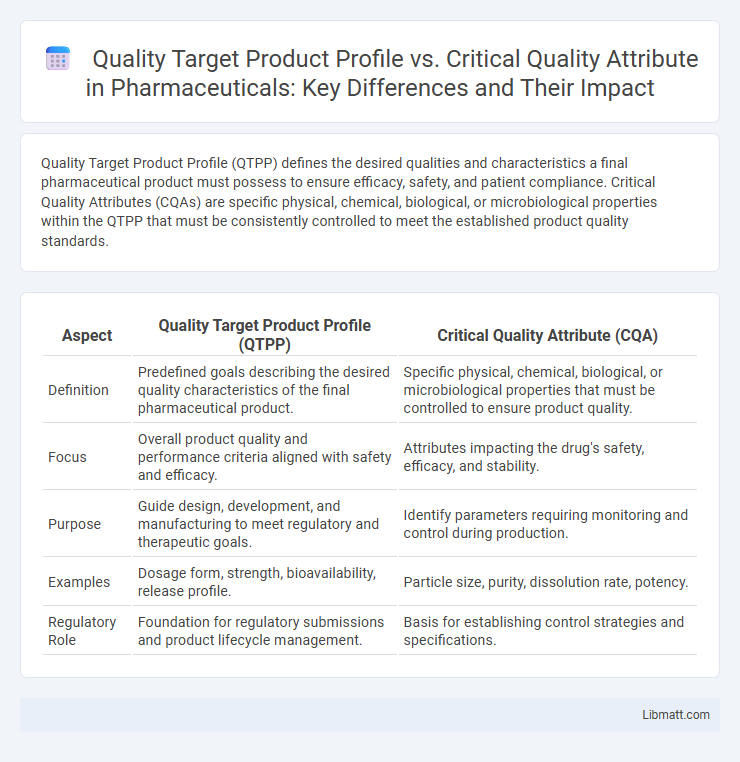Quality Target Product Profile (QTPP) defines the desired qualities and characteristics a final pharmaceutical product must possess to ensure efficacy, safety, and patient compliance. Critical Quality Attributes (CQAs) are specific physical, chemical, biological, or microbiological properties within the QTPP that must be consistently controlled to meet the established product quality standards.
Table of Comparison
| Aspect | Quality Target Product Profile (QTPP) | Critical Quality Attribute (CQA) |
|---|---|---|
| Definition | Predefined goals describing the desired quality characteristics of the final pharmaceutical product. | Specific physical, chemical, biological, or microbiological properties that must be controlled to ensure product quality. |
| Focus | Overall product quality and performance criteria aligned with safety and efficacy. | Attributes impacting the drug's safety, efficacy, and stability. |
| Purpose | Guide design, development, and manufacturing to meet regulatory and therapeutic goals. | Identify parameters requiring monitoring and control during production. |
| Examples | Dosage form, strength, bioavailability, release profile. | Particle size, purity, dissolution rate, potency. |
| Regulatory Role | Foundation for regulatory submissions and product lifecycle management. | Basis for establishing control strategies and specifications. |
Introduction to Quality Target Product Profile (QTPP)
The Quality Target Product Profile (QTPP) defines the desired characteristics of a final pharmaceutical product, ensuring it meets safety, efficacy, and quality standards. Critical Quality Attributes (CQAs) are specific physical, chemical, or microbiological properties that must be controlled to achieve the QTPP. Your development process uses the QTPP to guide formulation and manufacturing decisions, aligning product outcomes with regulatory expectations.
Defining Critical Quality Attributes (CQAs)
Critical Quality Attributes (CQAs) are the physical, chemical, biological, or microbiological properties that must be controlled to ensure the final product meets its desired Quality Target Product Profile (QTPP). Defining CQAs involves identifying attributes critical to safety, efficacy, and performance based on the QTPP and therapeutic use. Your understanding of CQAs guides development by highlighting essential parameters to monitor and control throughout the manufacturing process.
Importance of QTPP in Pharmaceutical Development
Quality Target Product Profile (QTPP) serves as a strategic foundation in pharmaceutical development, defining desired product characteristics to ensure safety and efficacy. It guides formulation design and process optimization by aligning critical quality attributes (CQAs) with regulatory standards and patient needs. Effective use of QTPP accelerates development timelines and minimizes risk by ensuring all CQAs meet predefined quality benchmarks.
Role of CQAs in Drug Product Quality
Critical Quality Attributes (CQAs) play a pivotal role in defining and ensuring the drug product quality by directly impacting its safety, efficacy, and performance. CQAs are the physical, chemical, biological, or microbiological properties that must be controlled within predefined limits to meet the Quality Target Product Profile (QTPP). Monitoring and managing CQAs throughout the manufacturing process helps maintain product consistency, compliance with regulatory standards, and ultimately patient safety.
Relationship Between QTPP and CQAs
The Quality Target Product Profile (QTPP) defines the desired product characteristics that ensure safety and efficacy, serving as a strategic framework for drug development. Critical Quality Attributes (CQAs) are specific physical, chemical, biological, or microbiological properties derived from the QTPP, directly impacting product quality. The relationship between QTPP and CQAs is essential for risk assessment and control strategies, as CQAs are established to meet the criteria set by the QTPP, ensuring consistent product performance.
Steps to Establishing QTPP
Establishing a Quality Target Product Profile (QTPP) involves defining the desired quality characteristics of the final product based on regulatory requirements, therapeutic goals, and patient needs. You start by identifying Critical Quality Attributes (CQAs), which are physical, chemical, biological, or microbiological properties that must be controlled to ensure product quality and efficacy. Next, align formulation and process development efforts to support these attributes, ensuring that your QTPP drives design space creation and risk management strategies.
Process of Identifying and Selecting CQAs
The process of identifying and selecting Critical Quality Attributes (CQAs) begins with defining the Quality Target Product Profile (QTPP), which outlines the desired product characteristics essential for safety and efficacy. CQAs are determined through a thorough risk assessment that evaluates the impact of material attributes and process parameters on the QTPP. Advanced analytical methods and quality risk management tools are applied to prioritize CQAs that must be controlled to ensure the final product meets predefined quality standards.
QTPP vs CQA: Key Differences
Quality Target Product Profile (QTPP) defines the desired characteristics of a final pharmaceutical product, including attributes like dosage form, strength, and release profile. Critical Quality Attributes (CQAs) are specific physical, chemical, biological, or microbiological properties that must be controlled within defined limits to ensure the QTPP is met. The key difference lies in QTPP representing the overall product goals, while CQAs focus on measurable parameters essential for achieving those goals.
Practical Examples Illustrating QTPP and CQAs
The Quality Target Product Profile (QTPP) outlines the intended attributes such as dosage form, strength, and route of administration, as seen in an oral tablet designed for sustained release with a duration of 12 hours. Critical Quality Attributes (CQAs) are specific measurable properties, like tablet hardness or dissolution rate, that directly impact the drug's safety and efficacy. For example, in a sustained-release tablet, maintaining a dissolution rate within 80-100% at 12 hours ensures consistent therapeutic effect, which is a CQA derived from the QTPP.
Impact of QTPP and CQAs on Regulatory Approval
Quality Target Product Profile (QTPP) defines the desired characteristics of a drug product, guiding the development process to meet regulatory standards. Critical Quality Attributes (CQAs) are specific, measurable properties that ensure the product meets the QTPP and maintains safety, efficacy, and quality. Your regulatory approval depends heavily on demonstrating control over CQAs aligned with the QTPP to satisfy health authorities' requirements.
Quality target product profile vs Critical quality attribute Infographic

 libmatt.com
libmatt.com